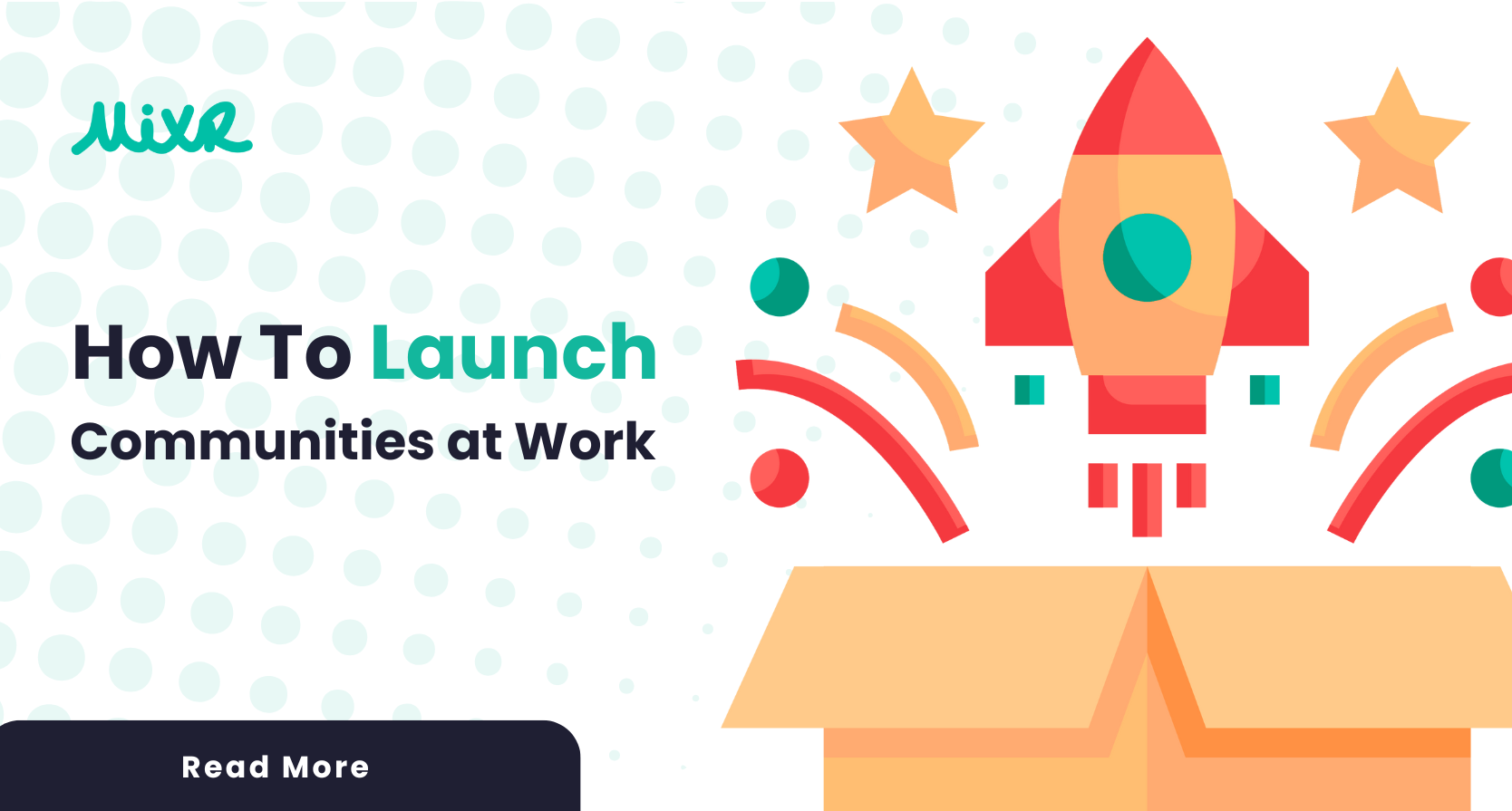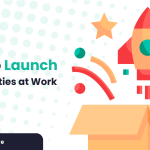
First off, it’s important to define what a community at work is. A community at work is a group of employees who come together around something they share (an interest, expertise, life experience, etc.) to exchange support, insights, and camaraderie. As such, communities at work offer flexible ways to connect an organization across its silos, nurture the social well-being of employees, and develop collective intelligence at scale. In other words, communities are where employees can access peer-generated value, and where they contribute their own.
These capabilities have always been advantageous for any organization, but in an era defined by the accelerating speed of change, communities have become crucial to stay ahead of the curve. So how can you start creating your own communities at work?
Communities thrive when they are set up to collect, grow, and redistribute knowledge and social capital. As such, communities at work can take many forms:
- Shared expertise: To promote the exchange of technical knowledge and support among employees who share expertise (Front-end development, Graphic design, etc.)
- Domain of practice: To connect stakeholders whose knowledge and responsibilities intersect at key steps of a value chain, especially those that do not regularly interact. Typically, exchanges in these communities are less technical than in expertise communities and allow a broader range of stakeholders to be involved. (Events & marketing, B2B sales, etc.)
- Shared interest: To promote meaningful social connections and belonging between employees (Paddle tennis, Sustainability, etc.)
- Life experiences: To give employees access to social support from peers who share certain life experiences (Working parents, Veterans, Cancer survivors, etc.)
- Togetherness: To help employees better serve each other and the community (Lost and Found, Carpooling, Volunteering, etc.)
As you can see, communities are much more open-ended than teams typically are. You could also deduce from these descriptions that communities are more geared towards continuous tasks, such as social support and staying up to date on market trends, whereas a team’s focus is typically set on discrete tasks, like finishing a report or developing a new product feature.
Both of these collaborative dynamics (continuous and discrete) are necessary to innovate and successfully carry out projects in a fast-paced work environment. Despite that, many companies still do not have a well-developed community strategy, making community a tremendous opportunity to develop a competitive advantage. Thankfully, creating vibrant communities at work is perfectly achievable with the proper approach and access to the right tools. On that note, let’s get right into the 5 key steps to building vibrant communities at work.
- Identify key communities to create
- Find the right tool to build and manage communities at work
- Assemble leadership teams
- Formalize the purpose and guidelines of your community
- Promote your community and gather members
How to identify employee communities to develop
It is important to have an open mind when deciding what your first communities are going to be. However, there are a few important factors to consider.
What are the best communities at work to create?
Within an organization, especially a large one, numerous communities can be created, but not all of them have the same potential for growth and value creation. Hence, the first step should be identifying organizational needs that a community could potentially address.
For example, you might look at a company and see that newly hired employees struggle to adapt and embrace the company culture. Consequently, the company faces heightened rates of attrition and disengagement in the first 6 months of employment. This is the perfect opportunity to create an onboarding community. In this community, members are brought together to connect with people who are going through the same hurdles they are.
This is a great example of a community at work because:
- The community has a clear business case: New employees have higher rates of disengagement and attrition, which compromises productivity and negatively affects the overall retention rate of your organization. This community will help fix that problem.
- The community has a clear social purpose: Community is at its best when it is set up to collect, grow, and redistribute social capital. In this example, new employees were struggling to adapt and feel included. But in an onboarding community, they can support each other, find their new work buddy, and exchange insights from their onboarding experience.
- The community brings together workers from multiple business units: Creating a community that brings together new employees connects stakeholders who would seldom interact through the regular course of their workday. In doing so, the community opens new channels of communication and collaboration across silos.
Often, the most successful communities offer value across these 3 pillars. By designing your initial communities around this blueprint, you can effectively launch your community-building project and nurture early adoption within your organization. This approach helps ensure that the first communities you create have a visible and measurable impact that can be relayed to leadership.
While creating new communities is important, don't discount existing resources within your organization. Look for unofficial, self-organized employee groups that already exist. These communities can offer valuable opportunities and identifying them serves two purposes: it reveals potential areas for official community development and highlights employees who have been proactively contributing to the organization's culture. Recognizing these dedicated individuals can be beneficial for your company.
How many communities at work should I aim to create initially?
This will depend on the size of your organization. For most organizations, a good starting point is to launch between 5 and 10 communities when initiating your community program. As your initiative grows and you're equipped with the right community platform, employees should feel empowered to develop or pitch new communities themselves. The richer and more diverse your community portfolio becomes, the more opportunities employees have to access relevant peer-generated value.
How to find the right platform to develop communities at work
When it comes to building a strong, engaged workforce, having a great employee community platform is essential. But what exactly makes a great community platform?
What makes a great community platform?
- Delightful User Experience: Your community platform will form the beating heart of your culture. Interacting with it must be an enjoyable experience. A great community platform will offer a beautiful interface that is easy to use and takes inspiration from the platforms employees already use at home. A poorly designed platform can kill adoption and limit the success of your community, so make sure you get the right one!
- Robust Communication Tool: As expected, an employee community platform needs to facilitate open communication and collaboration. The easier it is for employees to communicate and share information, the more vibrant the communities will be.
- Great employee profiles: Your employees deserve better than a digital contact card to share who they are. Look for a community platform that allows employees to build rich and detailed profiles. Your goal should be to make employees feel empowered to share who they are and feel seen as individuals. You won’t believe how many community platforms don’t offer good profile features!
- Matching and Connecting: Your platform should go beyond just hosting communities, it should actively encourage connections by prompting employees to interact and rewarding those who take the initiative to build a community. The ideal platform will use some form of AI and machine learning to intelligently surface relevant synergies between employees based on their role, interests, interactions and other shared characteristics.
- Analytics and Reporting: You'll want to be able to track the health and effectiveness of your communities over time. Look for platforms with robust analytics that provide insights into active users, top contributors, most popular content, and overall engagement metrics. This data is necessary to continuously optimize your community strategy.
The right employee community platform can help foster better communication, collaboration, knowledge sharing, and a strong company culture. But not all platforms are created equal. By prioritizing these five essential features, you can select a platform that truly empowers your employees and takes your organization to the next level.
If you’re looking for an employee community platform, we recommend you check out MixR!
It’s time to assemble a leadership team
If you’ve chosen the right platform that aligns with your needs, managing a community shouldn’t be too much of a problem. But someone still needs to do it. Unlike teams, communities are typically self-organized, meaning that members of the community are in charge of managing it. As a result, once you have a good idea of what communities you would like to create, you need to find champions who want to lead the communities.
Each community that you decide to create should include between 3-5 leaders who can share the task of managing the community. To assemble the leadership teams, you will need to develop an internal communications campaign and create a recognition program to incentivize community leadership.
The best champions will:
- Be passionate about the community’s purpose.
- Have strong communication and organizational skills.
- Be respected and trusted by their peers.
With that said, one of the beautiful things about a community is that anyone can become a leader, even an entry level employee if they show a particular affinity for it. It is a source of status that does not compromise classical hierarchical relationships but nevertheless creates more opportunities for employees to show what they are capable of.
Ideally, each leadership team should bring together members who have diverse skills and perspectives. A good way of doing so is to include members from different departments or functions to provide a well-rounded perspective and to promote cross-functional collaboration. Keep in mind that communities often elect to define clear roles, such as:
- Community Manager: Oversees the overall functioning of the community.
- Content Creator: Develops and curates content for the community.
- Event Coordinator: Plans and executes community events and activities.
How to formalize the purpose and guidelines of your community
Now that you have identified the communities that you want to create and gathered up your champions, it’s time to get into more detail on what each employee community will look like. Here are the key elements that a community should have before launching:
- A catchy name: Sometimes a good name makes all the difference. Make sure the name is enticing and makes the purpose of your community clear.
- A clear description: This is where you have to ask yourself about what is expected out of the community and its members. Clearly communicating the purpose of a community is essential to its success, so take your time when writing your description.
- Community guidelines: This is the set of rules that every member of the community is expected to follow (such as not sharing offensive content or participating in at least one get-together/mixr a year).
- A rough content strategy: Our best advice here is to keep it simple. A good community content strategy should be focused on giving a voice to members and encouraging them to share their opinions and insights.
- A tentative schedule for future mixrs: You don’t need to know exactly what you will do and when, but communities need privileged meeting time in order to thrive and you should have a rough idea of how often your members will meet and what kinds of events you want to focus on (after-works, webinars, etc.)
Promote your community and gather members
You’re on the home stretch to launch your new community. It's time to get the word out and onboard new members to your community platform. Here are 5 ways to make sure your new community at work succeeds:
- Get leadership buy-in and make it obvious: This is very important. If employees feel that the company’s top leadership doesn’t care about the launch of a community initiative and everything that it offers, they won’t either. Make sure to put your leadership’s endorsement front and center with community members sharing their excitement and objectives for the community.
- Give your champions the spotlight: The champions you gathered ahead of your announcement represent the intrapreneurship, commitment, and leadership that every employee should have. Make sure to highlight their efforts by releasing a special profile. Another option is an all hands or other internal shout out. You could even give kudos by posting a social media update.
- State your objectives clearly: Make sure that the goals of your community (improving employee experience, building collective intelligence, etc.) are stated clearly so that your employees know what is expected of them, what the company has to gain, and what members have to gain from engaging with the community.
- Get started early: Give yourself some runway to get everyone on board. Typically, we find that the most successful companies begin discussing their community strategy in company-wide comms 6 to 8 weeks before the launch of the community. Make sure to reference the project and provide more information on it regularly until and after launch date.
- Have a clear launch date and dedicated time to sign up: Driving early adoption and signups is difficult when introducing a new platform or initiative. Choose a specific date to launch your community (give yourself enough time to prepare) and build excitement around it. Treat the launch of your community like a major event (it is!). Finally, coordinate with middle managers and ask them to reserve time for their teams to sign up to the platform on launch day.
You’re Ready to Start Building Communities at Work!
Launching communities at work is the most effective strategy for fostering connections, enhancing social well-being, and harnessing collective intelligence within your organization. By creating spaces where employees can share interests, expertise, and support each other, you break down silos and encourage a culture of collaboration and mutual growth.
To create your own vibrant communities, make sure to follow our guide and don't forget to identify relevant communities, choose the right platform, assemble dedicated leadership teams, formalize community guidelines, and actively promote engagement.
Remember, the success of these communities' hinges on the support and involvement of all stakeholders, from top leadership to individual contributors. By investing in the creation and growth of these communities, you lay the groundwork for a thriving, connected, and forward-thinking organization.
When it comes to choosing the right platform to build and manage these communities, MixR stands out as the best solution. MixR offers an intuitive user experience, robust communication tools, comprehensive employee profiles, and intelligent employee matching systems that foster connections and community growth. With MixR, you can effortlessly track community health and engagement through powerful analytics and reporting features.
Have any questions about building communities at work? Please reach out!







